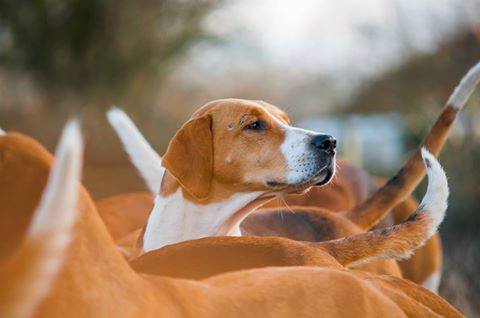
{photo credit RFM Equine}
We have been out of the public eye since our Facebook page was stolen, but now we are back. We think we should get back to basics, and today, we’d like to talk about hounds.
Without the hounds, we would have no hunting. Some folks hunt to ride, and some of us ride to hunt. The ride-to-hunt crowd is more likely to enjoy the hounds unraveling the intricate line of the fox or the drag, as it may be. But even the hunt-to-ride crowd can’t ignore the spine-tingling thrill of listening to their cry as they “speak” on the line. Hounds don’t bark – they “give tongue,” “open,” or “speak” when they are working. When they are working, keep your eyes and ears open, your voice down, and your mouth shut.
We refer to hounds as hounds, not dogs, regardless of sex. However, a male hound is known as a or a dog hound (confusing, I know), and a female is known as a bitch or a bitch hound. A hound has a stern instead of a tail. He may wag his stern when greeting you, but if he is on the line, he “feathers” his stern straight up. Hounds are always counted in couples, so 12 and a half couple = 25 hounds. The Huntsman will always bring that extra half because superstition says the odd one catches the fox.
When you are in the field, keep your horse at least 10 yards away from the hounds and much further if they are at work. If a hound is about to pass you on the ground, make sure you turn your horse’s head towards the hound. The greatest faux pas you could ever make is to have your horse kick a hound. So pay attention; if someone says “hounds please” or “ware hound,” keep your distance, and if a hound is lagging behind, make way for them to catch up.
We hope this helps you brush up on hound knowledge and etiquette.
KICK ON!


